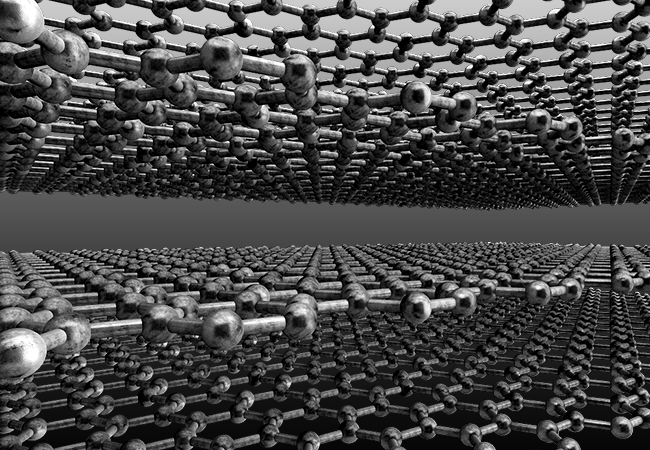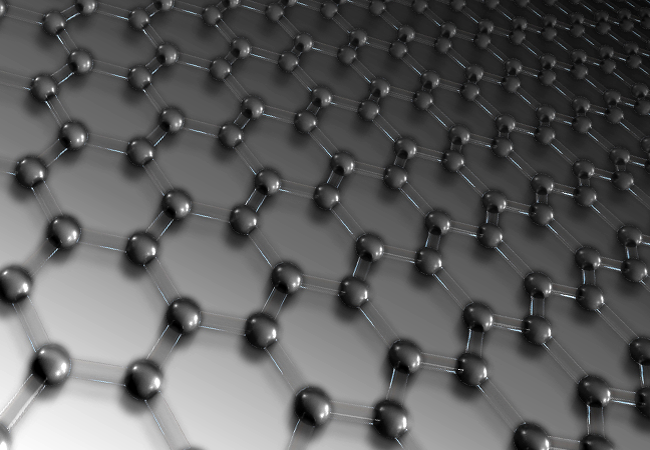-
"A film about graphene" directed by Karin Wegsjأ¶. آ© The Nobel Museum 2014
-
Graphene is

Graphene is a form ofآ carbonآ allotrope consisting ofآ planarآ sheets which are oneآ atom thick carbon atomsآ arranged in aآ honeycomb-shaped (hexagonal)آ lattice. Graphene has many extraordinary properties. It is about 100~300 times stronger than steel with tensile stiffness ~1020 GPa. It is the best conductor of heat at room temperature (thermal conductivity ~ 5300 Wآ·m−1آ·K−1) and also the best conductor of electricity known (studies have shown electron mobility at values of more than 15,000 cm2آ·V−1آ·s−1) and it is optically transparent (with light absorption at د€خ± ≈ 2.3% of white light or 97.7 % transmittance).
VIEW GRAPHENE SAMPLE
Because it is less than one atomic thickness (0.33 nm) or about one million times thinner than a sheet of paper, it is very light materials weighing about 0.77 mg/m2 and has extremely high surface area(theoretical specific surface is of 2630 m2/g).

Historically, Scientists have theorized about graphene for decades. It has likely been unknowingly produced in small quantities for centuries, through the use of pencils and other similar applications of graphite. It was originally observed in electron microscopes in 1962, but not studied further. The material was later re-discovered, isolated and characterized in 2004 by Andre Geim and Konstantin Novoselov at the University of Manchester. In Sept. 2005, Philip Kim et al at Columbia University reported observation of the Quantum Hall effect in single graphene layers simultaneously with the group of Andre Geim and Konstantin Novoselov in 2007, the two groups jointly published observatios of the Quantum Hall effect in graphene at room temperature. In 2010, Andre Gim and Konstantin Novoselov later became the two receiptience of the Nobel Prize in Physics in for groundbreaking experiments regarding the two-dimensional material graphene. Since 2004, scientist continue research on Graphene’s novel properties such as the bipolar transistor effect, magnetism, ballistic transport of charges and large quantum oscillations in graphene, expanding the applicability of graphene materials.
7 Features of Graphene
- Strongest material ever tested, 200 times stronger than steel (Tensile strength ~130 GPa, Stiffness ~ 1.1 TPa).
- Best conductor of electricity ever known (resistivity of 10 ohm/cm), electron mobility ~ 40,000 cmV-1s-1
- The best conductor of heat at room temperature (thermal conductivity of 5,300 Wm-1K-1)
- Highly optical transparency (97.7 % transmittance, 2.3% white light absorption per/layer)
- It is an atomically thin materials (0.33 nm), one million times thinner than a sheet of paper.
- Has extremely high surface area (2,630 m2/g)
- It is a very light material, about 0.77 mg/m2 or about 0.001% of the weight of 1 m2of paper.

Carbon Nanotube An allotropes of carbon, where carbon atomsآ arranged in aآ honeycomb-shaped (hexagonal)آ sheet and the sheet is rolled into a cylindrical nanostructure (1D) in the form of single sheet (single wall carbon nanotube) or multi sheets (multiwall carbon nanotube).
Fullerene A molecule of carbon, with similar carbon arrangement as in CNT but theآ lattice is wrapped into a nano bulky ball structure (hollow sphere, ellipsoid).


Graphite 3D crystalline carbon consisting of graphene layers supper posited each others.
Graphene 2D form ofآ carbonآ allotrope consisting ofآ planarآ sheets which are oneآ atomآ thick carbon atomsآ arranged in aآ honeycomb-shaped (hexagonal)آ lattice.




